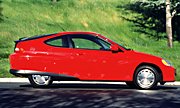by Mark Liberator (e-mail: editor@liberator.net) [June 23rd, 2004]
There are a new line of cars coming out that will make the self-proclaimed eco-warriors of the world extremely happy. Of course, their happiness stems from an acute infection of ignorance but this would hardly be a break from their previous state of being. Allow me to form a few images so that these misguided eco-flub-a-dubs can comprehend alternative fuel vehicles.
| “It is clear, there may be lower costs at the pump, but hidden fees lurk like prowling burglars in shadows.” |
Do not fall prey to “If You Wanna,” “Wind Beneath My Wings,” or an overplayed Kool & The Gang song. Learn more about these autos. Sure, it’s difficult to argue against cars that deliver 60 to 70 miles per gallon. The eco-warriors of the world will claim improved gas mileage translates to restricted car emissions and a decrease in air pollution. It could also be argued that these cars will promote a healthier ecological consciousness.
Of course, these arguments would be fundamentally flawed, but it wouldn’t stop eco-warriors from arguing the case. People may be foolish enough to rest their faith in these misguided souls and the erred arguments they profess. Maybe the general population will take cues from the songs. These cars may be here and better be purchased because they will go fast, but I wouldn‘t want ‘em. The cars could be the wind from something that came and went; who knows?
Know the implications hidden behind these autos before anyone celebrates good times. These uber-cars have great gas mileages because they are hybrids, specifically called hybrid electric vehicles or HEVs. They operate using two power sources, one gas and the other electric. They possess the standard internal combustion engines in conjunction with batteries for electrical propulsion. Therefore, the energy that drives these cars is split between gasoline and electricity. The eco-knuckleheads will focus their attention on the gas mileage and will be unable to acknowledge the other source due to the blinders they wear.
If we lift the blinders, we may be able to investigate electricity and learn something about the trade off from the burning of fossil fuels to the force that drives electricity. Be patient, because here comes a science lesson riddled with jargon. Electricity can be manufactured by an object that spins a magnet, called a generator. Operating the generator requires a large force if the generator is large. So, there are three main ways electric plants operate.
There are plants that are run by flowing water, the release of steam, and nuclear energy. Hydro-electric plants manipulate water in such a way that as water is allowed to fall down through metal blades, it turns a generator. The creation of steam used to turn the blades of a generator is brought on by the burning of coal -- a fossil fuel. There are also nuclear power plants that turn generators using energy that is emitted by the decay of radioactive elements.
Each of the three plants have huge disadvantages. There is 1) a damaging ecological change in environment of plants and animals caused by hydro-electric dams, 2) air pollution from burning fossil fuels, and 3) a radioactive hazard, lasting hundreds of thousands of years, with the nuclear waste byproduct resulting from nuclear powered plants. The sum of this information means car buyers and eco-warriors must not jump to wild conclusions regarding lower gas mileage vehicles.
The pollution is still there, even though it is hidden from direct view. Just because hybrid vehicles are producing better emissions, one might believe they offer a positive alternative to the standard internal combustion engine. Doing so would be a huge error that ignores the indirect but equally damaging effects from electric sources.
The only possible benefit would be a lowered dependence on foreign oil. Yet, the United States uses approximately 10 million barrels a day. Moving toward hybrid vehicles would displace 200 million of those barrels per year, or only about 20 days of average activity. It may be a start but it is a long way off from doing any good, especially since those 200 MB would require burning 40 million tons of coal. The effect may lower U.S. foreign oil dependency but it replaces it with air pollution.
|
There are also a few issues related to batteries. The batteries have a lifespan of only 8 - 10 years. The cost is a shocking $6800 for a new Toyota Prius or Honda Insight battery. Then there is the issue of battery disposal, which is yet another environmental concern. It is clear, there may be lower costs at the pump, but hidden fees lurk like prowling burglars in shadows.
The cost of an entire hybrid vehicle is not what it seems. It costs approximately $5,000 more than its fossil fuel burning equal. If one were to factor in the approximate $200 savings/year that hybrid vehicles offer, it is projected that it would take nearly 15 years to pay the difference even under gas rates thought to be increasing during that time. A $2000 tax credit signed by Bush may help, but it would still take years to recoup the difference. Let’s not even begin to factor in repair costs of a hybrid system or what a hybrid car owner would have to endure to receive quality service.
It is clear that moves toward alternative fuel sources (AFS) is a superb idea. Hydrogen, natural gas, propane and methanol are being researched for their effectiveness within vehicles as fuel cells and alternative fuel sources. The efficiency of gasoline, electricity, and fuel cells is 20%, 20 - 26%, and 24 - 32%, respectively. Due to the efficiency of fuel cells, it is easy to predict their eventual use within cars, but the basic car owner will be forced to wait about 10 - 20 years. Only then may eco-warriors have something to report and celebrate.
Reference List
